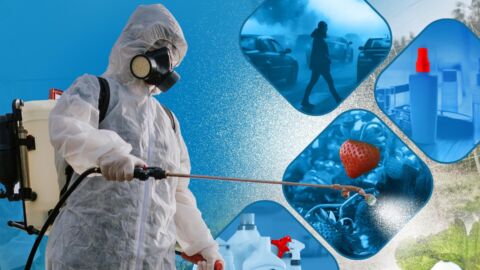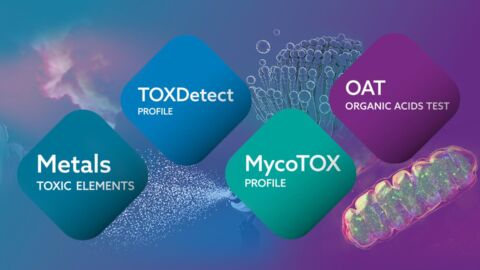Environmental toxins, as detected by our TOXDetect Profile®, play a significant role in understanding our exposures. By recognizing how they are metabolized, even more insights can be gleaned about timing of exposure, the ability to eliminate them, and what additional influences they may be having on the system. It is essential to note that many of these toxicants are lipophilic, meaning they have an affinity for fat, allowing them to be more readily absorbed, particularly from dermal exposures.1 Being lipophilic means they also have a higher potential to be stored in lipids (e.g. cell membranes, adipose tissue), and need to go through biotransformation (i.e. Phase I and II of detoxification) to be eliminated.1 The chart below illustrates the parent compound, the metabolite of the parent compound, half-lives, and metabolic processes of these toxicants, including common classes such as phthalates, volatile organic compounds (VOCs), and pesticides. Phthalates, often found in plastics, VOCs from industrial emissions, and pesticides used in agriculture are prominent examples of environmental contaminants that the body must process and eliminate.
The liver is crucial in managing these lipophilic substances, as it transforms them through a series of detoxification phases to make them more hydrophilic (water-soluble) and easier to secrete. This process involves three key phases: Phase I, Phase II, and Phase III, each playing a unique role in detoxification. For a comprehensive understanding of these phases and nutrients that support these intrinsic reactions, you can refer to The Liver: It’s Important Role in Detoxification and The Liver: Supportive Nutrients in Detoxification. The first article details the phases and specific reactions involved in liver detoxification, while the second explores the nutrients and plant derivatives that enhance these processes and promote liver health.
Yes/No
Di‑n‑butyl Phthalate (DBP)
Di(2‑ethylhexyl) Phthalate (DEHP)
for most metabolites.1
Phase II: Metabolites are conjugated with glucuronic acid and excreted via urine.3
May negatively impact mitochondrial function and the human microbiome4,5 (may consider Organic Acid Test (OAT) and Comprehensive Stool Analysis(CSA)).
Supporting microbiome with probiotics may decrease toxicity.5
Yes/No
Dermal exposure: 11.1‑30.2 hrs7
Phase II: Primarily involves conjugation reactions, including glucuronidation (UGTs) and sulfation (SULTs).9,10
Phase II: Glucuronidation and sulfation of BPS facilitate detoxification and excretion via urine.12 These metabolites are generally considered inactive (related to endocrine disruption) compared to the parent compound.13
Yes/No
Slower phase: 20‑58 hours depending on the tissue.
Then, excreted via urine.15
Can cause mitochondria damage and deplete glutathione (may consider OAT).17
Then converted by mEH to form phenylglyoxylic acid, mandelic acid, and hippuric acid.7
Styrene Phase II: SO undergoes glutathione (GSH) conjugation to form PGO.19
Ethylbenzene: Hydroxylation by CYP2E1 mainly, but can also go through CYP1A2 and CYP2B6 to a lesser degree.20
Mandelic and hippuric acids are intermediates of Styrene’s breakdown in the body (may consider OAT).21
Phase II: GSH conjugation results in formation of NAP.23
Broccoli sprouts can enhance detoxification.23
Can be stored in bone marrow, causing a decrease in red blood cells and anemia.24
Phase II: ACN conjugates with glutathione to form NACE and excrete via urine.26
Phase I: CYP2E1 oxidation leads to formation of 1‑bromo‑2‑propanol and bromacetone.
Phase II: Conjugates with GSH to form various mercapturic acids including NAPR.30
Observed effects on neurotransmitter metabolites (DOPAC, HVA, and 5‑HIAA)32 (may consider OAT).
Phase II: Several transformations involving GSH conjugation, forming mercapturic acids to be excreted via urine.31
GSTT1 polymorphisms influence metabolism and detoxification.33
Vinyl Chloride (VC)
VC: Yes
VC: 1‑2 days
EO Phase II: Conjugation with GSH mediated by Glutathione S‑transferase (GST).34
VC Phase I: Also metabolized by CYP2E1 to form CEO and CAA, and undergoes hydrolysis.
VC Phase II: GSH conjugation.35 36
VC can cross the placenta and enter the fetus.30
Yes/No
Ethylparaben (EtP)
Propylparaben (PrP)
Butylparaben (BuP)
from 7.7‑20.3 hrs.41
MeP: 12.2 hrs, EtP: 12.0 hrs,
PrP: 9.3 hrs.42
Phase II: Primarily undergo glucuronidation via UGTs.45
Yes/No
Phase II: Key enzymes in phase II are GST, specifically the pi class GST (hGSTP1-1).48
Phase II: Metabolites formed in Phase I reactions, such as 3PBA, may undergo further conjugation with amino acids, sulfates, and sugars.53
Detoxification: Involves dearylation of OPs to form inactive metabolites. CYP2C19 and 3A4 significantly contribute to this pathway, but 2C19is involved in detoxification of chlorpyrifos and diazinon, converting them to non‑toxic metabolites.56
Paraoxonase 1 (PON1) is involved in the hydrolysis of certain OPs. Polymorphisms in this enzyme increase susceptibility to toxicity.59 PON1 can be upregulated by pomegranate juice.60
Yes/No
Phase II: Hydroxylated metabolites undergo conjugation, such as glucuronidation, to form glucuronide conjugates to be more water‑soluble.62
Oxidation to Glycidamide: this is done via CYP2E1. Glycidamide is considered a more reactive and potentially genotoxic metabolite.64
GSH precursors such as NAC and methionine have been shown to protect against the cytotoxicity of AA and other metabolites.66
Phase II: The hydroxylated metabolites are conjugated with glucuronic acid or sulfate, making them more water‑soluble for excretion.72
Summary
TOXDetect Profile® offers a comprehensive approach to evaluating environmental toxicant exposures, complemented by a thorough environmental exposure history intake. This combination equips practitioners with insights needed to understand how toxins influence patient health and to implement evidence-based avoidance strategies, address health impacts, and tailor personalized therapeutic interventions. Our goal is to empower you to proactively mitigate the effects of environmental toxins, fostering long-term health and well-being for both you and your patients.
Get Deeper Insights into the Body’s Toxic Burden with EnviroTOX™
The EnviroTOX™ suite offers practitioners a comprehensive set of panels for detecting and assessing toxic exposures and their health impacts. The EnviroTOX Burden panel is a key component, combining multiple profiles – including the TOXDetect Profile®, MycoTOX Profile™, and Metals – Toxic Elements – to provide an extensive screening for a wide range of toxic exposures.
References
- In Vitro Metabolism of Di(2-Ethylhexyl) Phthalate (DEHP) by Various Tissues and Cytochrome P450s of Human and Rat.Choi K, Joo H, Campbell JL, et al. Toxicology in Vitro : An International Journal Published in Association With BIBRA. 2012;26(2):315-22. doi:10.1016/j.tiv.2011.12.002.
- Hydrolysis of Dibutyl Phthalate and Di(2-Ethylhexyl) Phthalate in Human Liver, Small Intestine, Kidney, and Lung: An in Vitro Analysis Using Organ Subcellular Fractions and Recombinant Carboxylesterases. Isobe T, Ohkawara S, Mori Y, et al.Chemico-Biological Interactions. 2023;372:110353. doi:10.1016/j.cbi.2023.110353.
- Genuis SJ, Beesoon S, Lobo RA, Birkholz D. Human elimination of phthalate compounds: blood, urine, and sweat (BUS) study. ScientificWorldJournal. 2012;2012:615068. doi:10.1100/2012/615068
- Kabekkodu, S. et al. The mitochondrial linkL Phthalate exposure and cardiovascular disease. BBA- Molecular Cell Research.
- Goyal, S. Et al. An insight into the critical role of tgut microbiota in triggering the phthalate-induced toxicity and it’s mitigation using probiotics. Science of the Total Environment. 2023. 904 (15); doi: 166889
- Thayer KA, Doerge DR, Hunt D, et al. Pharmacokinetics of bisphenol A in humans following a single oral administration. Environ Int. 2015;83:107-115. doi:10.1016/j.envint.2015.06.008
- Sasso AF, Pirow R, Andra SS, et al. Pharmacokinetics of bisphenol A in humans following dermal administration. Environ Int. 2020;144:106031. doi:10.1016/j.envint.2020.106031
- Ousji O, Ohlund L, Sleno L. Comprehensive In Vitro Metabolism Study of Bisphenol A Using Liquid Chromatography-High Resolution Tandem Mass Spectrometry. Chem Res Toxicol. 2020;33(6):1468-1477. doi:10.1021/acs.chemrestox.0c00042
- Street CM, Zhu Z, Finel M, Court MH. Bisphenol-A glucuronidation in human liver and breast: identification of UDP-glucuronosyltransferases (UGTs) and influence of genetic polymorphisms. Xenobiotica. 2017;47(1):1-10. doi:10.3109/00498254.2016.1156784
- Durcik M, Gramec Skledar D, Tomašič T, Trontelj J, Peterlin Mašič L. Last piece in the puzzle of bisphenols BPA, BPS and BPF metabolism: Kinetics of the in vitro sulfation reaction. Chemosphere. 2022;303(Pt 2):135133. doi:10.1016/j.chemosphere.2022.135133
- Influence of Metabolism on Endocrine Activities of Bisphenol S. Skledar DG, Schmidt J, Fic A, et al. Chemosphere. 2016;157:152-9. doi:10.1016/j.chemosphere.2016.05.027.
- Last Piece in the Puzzle of Bisphenols BPA, BPS and BPF Metabolism: Kinetics of the in Vitro Sulfation Reaction. Durcik M, Gramec Skledar D, Tomašič T, Trontelj J, Peterlin Mašič L. Chemosphere. 2022;303(Pt 2):135133. doi:10.1016/j.chemosphere.2022.135133.
- Disposition and Metabolism of the Bisphenol Analogue, Bisphenol S, in Harlan Sprague Dawley Rats and B6c3f1/N Mice and in Vitro in Hepatocytes From Rats, Mice, and Humans. Waidyanatha S, Black SR, Snyder RW, et al. Toxicology and Applied Pharmacology. 2018;351:32-45. doi:10.1016/j.taap.2018.05.008.
- Human Cytochrome P450 Isoform Specificity in the Regioselective Metabolism of Toluene and O-, M- And P-Xylene. The Journal of Pharmacology and Experimental Therapeutics. 1996;276(1):101-8. doi:10.1163/2211730x96x00063.
- Estimation of the Dermal Absorption of M-Xylene Vapor in Humans Using Breath Sampling and Physiologically Based Pharmacokinetic Analysis. Loizou GD, Jones K, Akrill P, Dyne D, Cocker J. Toxicological Sciences : An Official Journal of the Society of Toxicology. 1999;48(2):170-9. doi:10.1093/toxsci/48.2.170.
- Kinetics of M-Xylene in Man: General Features of Absorption, Distribution, Biotransformation and Excretion in Repetitive Inhalation Exposure. Riihimäki V, Pfäffli P, Savolainen K, Pekari K. Scandinavian Journal of Work, Environment & Health. 1979;5(3):217-31. doi:10.5271/sjweh.3096.
- Salimi A, Talatappe BS, et al. Xylene Induces Oxidative Stress and Mitochondria Damage in Isolated Human Lymphocytes. Toxicol Res. 2017 Jul;33(3):233-238. doi: 10.5487/TR.2017.33.3.233.
- Investigation of Bioactivation and Toxicity of Styrene in CYP2E1 Transgenic Cells. Chung JK, Yuan W, Liu G, Zheng J. Toxicology. 2006;226(2-3):99-106. doi:10.1016/j.tox.2006.06.001.
- Atsdr.cdc.gov. 2022. [online] Available at: https://www.atsdr.cdc.gov/ToxProfiles/tp53-c1-b.pdf [Accessed 1 October 2022].
- Metabolism of Ethylbenzene by Human Liver Microsomes and Recombinant Human Cytochrome P450s (CYP). Sams C, Loizou GD, Cocker J, Lennard MS. Toxicology Letters. 2004;147(3):253-60. doi:10.1016/j.toxlet.2003.11.010.
- [Qronfla MM,et. al. Synthesis and Characterization of a New Molecularly Imprinted Polymer for Selective Extraction of Mandelic Acid Metabolite from Human Urine as a Biomarker of Environmental and Occupational Exposures to Styrene. Polymers (Basel). 2023 May 21;15(10):2398. doi: 10.3390/polym15102398.
- The Fate of Benzene-Oxide. Monks TJ, Butterworth M, Lau SS. Chemico-Biological Interactions. 2010;184(1-2):201-6. doi:10.1016/j.cbi.2009.12.025.
- Ashraf M. Emara & Hoda El-Bahrawy (2008) Green Tea Attenuates Benzene-Induced Oxidative Stress in Pump Workers, Journal of Immunotoxicology, 5:1, 69- 80, DOI: 10.1080/15476910802019029
- Ashraf M. Emara & Hoda El-Bahrawy (2008) Green Tea Attenuates Benzene-Induced Oxidative Stress
- Chen JG, Johnson J, Egner P, et al. Dose-dependent detoxification of the airborne pollutant benzene in a randomized trial of broccoli sprout beverage in Qidong, China. Am J Clin Nutr. 2019;110(3):675-684. doi:10.1093/ajcn/nqz122
- Center for Disease Control. Facts about Benzene. 2018. https://emergency.cdc.gov/agent/benzene/basics/facts.asp#:~:text=Benzene%20causes%20harmful%20effects%20on,increasing%20the%20chance%20for%20infection.
- Role of Cytochrome P450 2E1 in the Metabolism of Acrylamide and Acrylonitrile in Mice. Sumner SC, Fennell TR, Moore TA, et al. Chemical Research in Toxicology. 1999;12(11):1110-6. doi:10.1021/tx990040k.
- Species Differences in Acrylonitrile Metabolism and Toxicity Between Experimental Animals and Humans Based on Observations in Human Accidental Poisonings. Thier R, Lewalter J, Bolt HM. Archives of Toxicology. 2000;74(4-5):184-9. doi:10.1007/s002040000109
- Wang S, Xing G, Li F, et al. Fasting Enhances the Acute Toxicity of Acrylonitrile in Mice via Induction of CYP2E1. Toxics. 2022;10(6):337. Published 2022 Jun 19. doi:10.3390/toxics10060337
- The Oxidative Metabolism of 1-Bromopropane in the Rat. Jones AR, Walsh DA. Xenobiotica; The Fate of Foreign Compounds in Biological Systems. 1979;9(12):763-72. doi:10.3109/00498257909042344.
- Species and Sex-Dependent Toxicokinetics of 1-Bromopropane: The Role of Hepatic Cytochrome P450 Oxidation and Glutathione (GSH). Garner CE, Yu X. Xenobiotica; The Fate of Foreign Compounds in Biological Systems. 2014;44(7):644-56. doi:10.3109/00498254.2013.879624.
- Center of Disease Control. ATSDR 1- Bromopropane Tox Profile. 2017. https://www.atsdr.cdc.gov/ToxProfiles/tp209.pdf
- 1,3-Butadiene: I. Review of Metabolism and the Implications to Human Health Risk Assessment. Kirman CR, Albertini RJ, Sweeney LM, Gargas ML. Critical Reviews in Toxicology. 2010;40 Suppl 1:1-11. doi:10.3109/10408444.2010.507181.
- Atsdr.cdc.gov. 2022. 1,3-butadiene. [online] Available at: https://www.atsdr.cdc.gov/toxprofiles/tp28-c3.pdf [Accessed 1 October 2022].
- Boldry EJ, et, al. Genetic Determinants of 1,3-Butadiene Metabolism and Detoxification in Three Populations of Smokers with Different Risks of Lung Cancer. Cancer Epidemiol Biomarkers Prev. 2017 Jul;26(7):1034-1042. doi: 10.1158/1055-9965.EPI-16-0838.
- A Physiologically Based Toxicokinetic Model for Inhaled Ethylene and Ethylene Oxide in Mouse, Rat, and Human. Filser JG, Klein D. Toxicology Letters. 2018;286:54-79. doi:10.1016/j.toxlet.2017.07.896.
- Studies on the Metabolism of Vinyl Chloride. Antweiler H. Environmental Health Perspectives. 1976;17:217-9. doi:10.1289/ehp.7617217.
- ATSDR. ToxGuide for Vinyl Chloride. https://www.atsdr.cdc.gov/toxguides/toxguide-20.pdf
- Epa.gov. 2022. Acute exposure guideline levels for selected airborne chemicals. [online] Available at: https://www.epa.gov/sites/default/files/2014-09/documents/ethyleneoxide_final_volume9_2010.pdf [Accessed 1 October 2022].
- ATSDR. Ethylene Oxide: Chapter 3: Toxicokinetics, susceptible populations, biomarkers, and chemical interactions. https://www.atsdr.cdc.gov/ToxProfiles/tp137-c3.pdf
- Nguyen HT, Isobe T, Iwai-Shimada M, et al. Urinary concentrations and elimination half-lives of parabens, benzophenones, bisphenol and triclosan in Japanese young adults. Chemosphere. 2024;349:140920. doi:10.1016/j.chemosphere.2023.140920
- Shin MY, Choi JW, Lee S, et al. Pharmacokinetics of transdermal methyl-, ethyl-, and propylparaben in humans following single dermal administration. Chemosphere. 2023;310:136689. doi:10.1016/j.chemosphere.2022.136689
- Obringer C, Wu S, Troutman J, Karb M, Lester C. Effect of chain length and branching on the in vitro metabolism of a series of parabens in human liver S9, human skin S9, and human plasma. Regul Toxicol Pharmacol. 2021;122:104918. doi:10.1016/j.yrtph.2021.104918
- Jewell C, Prusakiewicz JJ, Ackermann C, et al. Hydrolysis of a series of parabens by skin microsomes and cytosol from human and minipigs and in whole skin in short-term culture. Toxicol Appl Pharmacol. 2007;225(2):221-228. doi:10.1016/j.taap.2007.08.002
- Abbas S, Greige-Gerges H, Karam N, Piet MH, Netter P, Magdalou J. Metabolism of parabens (4-hydroxybenzoic acid esters) by hepatic esterases and UDP-glucuronosyltransferases in man. Drug Metab Pharmacokinet. 2010;25(6):568-577. doi:10.2133/dmpk.dmpk-10-rg-013
- Mendaš G, Vuletić M, Galić N, Drevenkar V. Urinary metabolites as biomarkers of human exposure to atrazine: atrazine mercapturate in agricultural workers. Toxicol Lett. 2012;210(2):174-181. doi:10.1016/j.toxlet.2011.11.023
- Lang DH, Rettie AE, Böcker RH. Identification of enzymes involved in the metabolism of atrazine, terbuthylazine, ametryne, and terbutryne in human liver microsomes. Chem Res Toxicol. 1997;10(9):1037-1044. doi:10.1021/tx970081l
- Abel EL, Opp SM, Verlinde CL, Bammler TK, Eaton DL. Characterization of atrazine biotransformation by human and murine glutathione S-transferases. Toxicol Sci. 2004;80(2):230-238. doi:10.1093/toxsci/kfh152
- The Fate of 2,4-Dichlorophenoxyacetic Acid (2,4-D) Following Oral Administration to Man. Sauerhoff MW, Braun WH, Blau GE, Gehring PJ. Toxicology. 1977;8(1):3-11. doi:10.1016/0300-483x(77)90018-x.
- In Vitro Studies on the Chemical Reactivity of 2,4-Dichlorophenoxy Acetyl-S-Acyl-CoA Thioester. Li C, Grillo MP, Benet LZ. Toxicology and Applied Pharmacology. 2003;187(2):101-9. doi:10.1016/s0041-008x(02)00043-1.
- Biotransformation and Enzymatic Reactions of Synthetic Pyrethroids in Mammals. Mikata K, Isobe N, Kaneko H. Topics in Current Chemistry. 2012;314:113-35. doi:10.1007/128_2011_254.
- Metabolism of Deltamethrin and Cis- And Trans-Permethrin by Human Expressed Cytochrome P450 and Carboxylesterase Enzymes. Hedges L, Brown S, MacLeod AK, et al. Xenobiotica; The Fate of Foreign Compounds in Biological Systems. 2019;49(5):521-527. doi:10.1080/00498254.2018.1474283.
- The Pyrethroid Metabolites 3-Phenoxybenzoic Acid and 3-Phenoxybenzyl Alcohol Do Not Exhibit Estrogenic Activity in the McF-7 Human Breast Carcinoma Cell Line or Sprague-Dawley Rats. Laffin B, Chavez M, Pine M. Toxicology. 2010;267(1-3):39-44. doi:10.1016/j.tox.2009.10.003
- Hodoșan C, Gîrd CE, Ghica MV, Dinu-Pîrvu CE, Nistor L, Bărbuică IS, Marin ȘC, Mihalache A, Popa L. Pyrethrins and Pyrethroids: A Comprehensive Review of Natural Occurring Compounds and Their Synthetic Derivatives. Plants (Basel). 2023 Nov 29;12(23):4022. doi: 10.3390/plants12234022
- Human Hepatic Cytochrome P450-Specific Metabolism of the Organophosphorus Pesticides Methyl Parathion and Diazinon. Ellison CA, Tian Y, Knaak JB, Kostyniak PJ, Olson JR. Drug Metabolism and Disposition: The Biological Fate of Chemicals. 2012;40(1):1-5. doi:10.1124/dmd.111.042572.
- Metabolism of Chlorpyrifos by Human Cytochrome P450 Isoforms and Human, Mouse, and Rat Liver Microsomes. Tang J, Cao Y, Rose RL, et al. Drug Metabolism and Disposition: The Biological Fate of Chemicals. 2001;29(9):1201-4.
- Trinder M, McDowell TW, Daisley BA, et al. Probiotic Lactobacillus rhamnosus Reduces OrganophosphatePesticide Absorption and Toxicity to Drosophila melanogaster. Appl Environ Microbiol. 2016;82(20):6204-6213. Published 2016 Sep 30. doi:10.1128/AEM.01510-16
- Bagherpour Shamloo H, Golkari S, Faghfoori Z, et al. Lactobacillus Casei Decreases Organophosphorus Pesticide Diazinon Cytotoxicity in Human HUVEC Cell Line. Adv Pharm Bull. 2016;6(2):201-210. doi:10.15171/apb.2016.028
- Costa LG, et al. Paraoxonase 1 (PON1) as a genetic determinant of susceptibility to organophosphate toxicity. Toxicology. 2013 May 10;307:115-22. doi: 10.1016/j.tox.2012.07.011.
- Parsaeyan N, et al. Effect of pomegranate juice on paraoxonase enzyme activity in patients with type 2 diabetes. J Diabetes Metab Disord. 2012 Aug 31;11(1):11. doi: 10.1186/2251-6581-11-11.
- Metabolic Mechanism of Aryl Phosphorus Flame Retardants by Cytochromes P450: A Combined Experimental and Computational Study on Triphenyl Phosphate. Zhang Q, Ji S, Chai L, et al. Environmental Science & Technology. 2018;52(24):14411-14421. doi:10.1021/acs.est.8b03965.
- Determination of Glucuronide Conjugates of Hydroxyl Triphenyl Phosphate (OH-TPHP) Metabolites in Human Urine and Its Use as a Biomarker of TPHP Exposure. Su G, Letcher RJ, Yu H, Gooden DM, Stapleton HM. Chemosphere. 2016;149:314-9. doi:10.1016/j.chemosphere.2016.01.114.
- Comparison of Acrylamide Metabolism in Humans and Rodents. Fennell TR, Friedman MA. Advances in Experimental Medicine and Biology. 2005;561:109-16. doi:10.1007/0-387-24980-X_9.
- In Vivo Role of Cytochrome P450 2E1 and Glutathione-S-Transferase Activity for Acrylamide Toxicokinetics in Humans. Doroshyenko O, Fuhr U, Kunz D, et al. Cancer Epidemiology, Biomarkers & Prevention : A Publication of the American Association for Cancer Research, Cosponsored by the American Society of Preventive Oncology. 2009;18(2):433-43. doi:10.1158/1055-9965.EPI-08-0832.
- Excretion of Mercapturic Acids of Acrylamide and Glycidamide in Human Urine After Single Oral Administration of Deuterium-Labelled Acrylamide. Boettcher MI, Bolt HM, Drexler H, Angerer J. Archives of Toxicology. 2006;80(2):55-61. doi:10.1007/s00204-005-0011-y.
- Kurebayashi H, Ohno Y. Metabolism of acrylamide to glycidamide and their cytotoxicity in isolated rat hepatocytes: protective effects of GSH precursors. Arch Toxicol. 2006;80(12):820-828. doi:10.1007/s00204-006-0109-x
- Perchlorate Clinical Pharmacology and Human Health: A Review. Soldin OP, Braverman LE, Lamm SH. Therapeutic Drug Monitoring. 2001;23(4):316-31. doi:10.1097/00007691-200108000-00002
- Perchlorate and the Thyroid Gland. Wolff J. Pharmacological Reviews. 1998;50(1):89-105.
- Breastfed Infants Metabolize Perchlorate. Shelor CP, Kirk AB, Dasgupta PK, et al. Environmental Science & Technology. 2012;46(9):5151-9. doi:10.1021/es2042806.
- Wang M, Tan J, Qi Z, Ge X, Li G, Yu Y. A combined study of skin penetration by confocal Raman spectroscopy and human metabolism: A case of benzophenone-3 in sunscreen. Environ Pollut. 2024;340(Pt 1):122868. doi:10.1016/j.envpol.2023.122868
- Mao JF, Li W, Ong CN, He Y, Jong MC, Gin KY. Assessment of human exposure to benzophenone-type UV filters: A review. Environ Int. 2022;167:107405. doi:10.1016/j.envint.2022.107405
- Ye X, Kuklenyik Z, Needham LL, Calafat AM. Quantification of urinary conjugates of bisphenol A, 2,5-dichlorophenol, and 2-hydroxy-4-methoxybenzophenone in humans by online solid phase extraction-high performance liquid chromatography-tandem mass spectrometry. Anal Bioanal Chem. 2005;383(4):638-644. doi:10.1007/s00216-005-0019-4[1]
- Kim S, Choi K. Occurrences, toxicities, and ecological risks of benzophenone-3, a common component of organic sunscreen products: a mini-review. Environ Int. 2014;70:143-157. doi:10.1016/j.envint.2014.05.015












